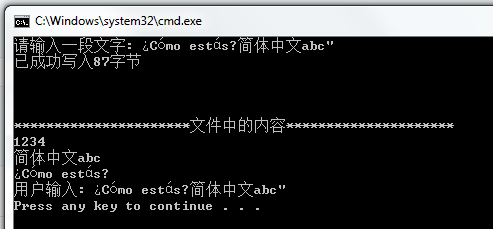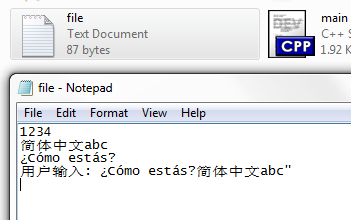【程式】給C++的cout和fstream新增Unicode支援,使其能向螢幕或檔案輸入/輸出wchar_t字串
阿新 • • 發佈:2019-02-07
【程式】
#include <fstream> #include <iostream> #include <Windows.h> #define RDBUF_LEN 200 using namespace std; ostream &operator << (ostream &os, const wchar_t *wstr) { if (os == cout) WriteConsoleW(GetStdHandle(STD_OUTPUT_HANDLE), wstr, wcslen(wstr), NULL, NULL); // 輸出到螢幕上 else { // 此時wstr是UTF-16編碼 // 將其轉換為UTF-8編碼後寫入檔案 int n = WideCharToMultiByte(CP_UTF8, NULL, wstr, -1, NULL, NULL, NULL, NULL); char *p = new char[n]; WideCharToMultiByte(CP_UTF8, NULL, wstr, -1, p, n, NULL, NULL); os.write(p, n - 1); delete[] p; } return os; } ostream &operator << (ostream &os, wstring &ws) { os << ws.c_str(); return os; } istream &operator >> (istream &is, wstring &ws) { int n = 0; wchar_t *wp; if (is == cin) { /* 從控制檯中輸入一行字串 */ bool complete = false; DWORD dwRead; // 實際讀到的字元個數 HANDLE hInput = GetStdHandle(STD_INPUT_HANDLE); wp = NULL; do { /* 分次迴圈讀取, 直到遇到換行符 */ wp = (wchar_t *)realloc(wp, (n + RDBUF_LEN + 2) * sizeof(wchar_t)); // 分配記憶體時始終為\r\n預留空間 ReadConsoleW(hInput, wp + n, RDBUF_LEN + 2, &dwRead, NULL); if (wp[n + dwRead - 2] == '\r') { wp[n + dwRead - 2] = '\0'; // 把\r換成\0, 並結束讀取 complete = true; // 注意: 當本次只讀到\n一個字元時, wp[n + dwRead - 2]指向上一次讀到的那一段的最後一個字元, 且一定是\r // 例如: [abc][de\r][\n ], 此時RDBUF_LEN=1, 第二次讀的時候n=3, dwRead=3, wp[3+3-2]=wp[4]是e而不是\r, 所以繼續 // 第三次讀的時候n=6, dwRead=1, wp[6+1-2]=wp[5]恰好是\r, 因此將\r替換成\0並退出迴圈 } else n += dwRead; } while (!complete); ws = wp; free(wp); } else { /* 從檔案中讀取一行字串 */ streampos start_pos = is.tellg(); // 記錄開始讀取的位置 char ch; while (ch = is.get(), !is.eof() && ch != '\r' && ch != '\n') n++; // 尋找換行符或檔案結束符出現的位置 is.seekg(start_pos); // 回到開始位置 // 讀取這一部分內容 char *p = new char[n + 1]; is.read(p, n); p[n] = '\0'; // 使檔案位置指標跳過換行符 while (ch = is.get(), !is.eof() && (ch == '\r' || ch == '\n')); if (!is.eof()) is.seekg(-1, ios::cur); // 轉換成UTF-16編碼 n = MultiByteToWideChar(CP_UTF8, NULL, p, -1, NULL, NULL); wp = new wchar_t[n]; MultiByteToWideChar(CP_UTF8, NULL, p, -1, wp, n); delete[] p; ws = wp; delete[] wp; } return is; } int main(void) { // 從控制檯中輸入Unicode字串 wstring wstr; cout << L"請輸入一段文字: "; cin >> wstr; // 開啟檔案並寫入Unicode字串 ofstream file("file.txt"); if (!file.is_open()) { cout << L"檔案開啟失敗" << endl; return 0; } file << L"1234" << endl; file << L"簡體中文abc" << endl; file << L"¿Cómo estás?" << endl; file << L"使用者輸入: " << wstr << endl; cout << L"已成功寫入" << file.tellp() << L"位元組" << endl; file.close(); // 開啟檔案並從檔案中讀取Unicode字串 ifstream ifile("file.txt"); cout << endl << endl << endl << L"**********************檔案中的內容*********************" << endl; while (!ifile.eof()) { ifile >> wstr; cout << wstr << endl; // 顯示 } ifile.close(); return 0; }
【執行結果】
【輸出的檔案】
【背景知識】
char字元陣列能存放任意編碼的字串
wchar_t在Windows系統下一般用來存放UTF-16編碼的字串,Linux下一般是UTF-32字串
在C/C++中,"xxx"型的字串的編碼與原始檔的編碼格式一致,而L"xxx"則統一為UTF-16(Windows) / UTF-32(Linux)編碼。
在Visual Studio中預設建立的原始檔的編碼格式是ANSI編碼,所以char xxx[] = "xxx"的編碼一般都是ANSI。
ANSI的編碼格式並不固定,它只是一個編碼對映。在簡體中文Windows作業系統下,ANSI指向的是GB2312編碼。由於英文版系統下ANSI並不指向GB2312編碼,所以開啟相關的文字檔案就會顯示為亂碼,而開啟UTF-8編碼的文字檔案就不會亂碼。
Windows API函式都分為ANSI和Unicode版本。例如SetWindowTextA接受的是char字元陣列,因為char字元陣列一般都是ANSI編碼,而SetWindowTextW接受的是wchar_t字元陣列(預設UTF-16編碼)
UTF-8、UTF-16和UTF-32是Unicode的三種實現方式。Unicode負責給每個字元編號,而這三種實現方式則按不同的方式儲存其編號。
C/C++中自帶的printf, cout等庫函式都不能正確輸出Unicode的字串,因為它們在輸出前都會將Unicode轉換成ANSI,導致字元資訊丟失,並且這個過程無法阻止。要想輸出Unicode字串只有呼叫Windows的API函式:WriteConsoleW。對於Unicode字串的輸入也有同樣的問題。
本文就是把這個功能封裝到了C++的cout裡面。


